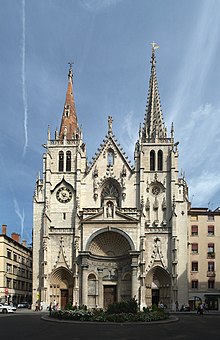Church of St. Nizier
| Église Saint-Nizier | |
|---|---|

Facade of the church
|
|
| Basic information | |
| Location | Lyon, France |
| Geographic coordinates | 45°45′53″N 4°50′01″E / 45.764711°N 4.833598°E |
| Affiliation | Roman Catholic |
| District | 2nd arrondissement of Lyon |
| Country | France |
| Leadership | Emmanuel Community |
| Architectural description | |
| Architectural type | Church |
| Architectural style | Gothic |
| Completed | late 16th century |
| Spire(s) | 2 |
The Church of Saint-Nizier is a church in the Presqu'ile district of Lyon, France, in the 2nd arrondissement, between the Place des Terreaux and the Place des Jacobins. Its name refers to Nicetius of Lyon, a bishop of the city during the 6th century.
The first religious building on the site of the present church was a Roman monument, perhaps a temple of Attis, whose worship was probably the cause of the Christian persecution in Lyon from 177. In the 5th century, according to tradition, Eucherius of Lyon, 19th bishop of Lyon, built on the ruins of the building a basilica to contain the relics of the martyrs in Lyon, tortured in 177. The church received the name "Church of Holy Apostles". In the 6th century, the bishops were buried in the church, particularly Nicetius of Lyon, the 28th bishop. The body of the latter attracted a crowd and his presumed great miracles led the church to take his name.
Saint Austregisilus was abbot here during the 7th century.
In the early 8th century, the church has been ravaged by the Saracens and by Charles Martel. It was rebuilt in the 9th century, at the behest of the bishop Leidrade.Peter Waldo, in the 13th century, was a parishioner. His disciples, shocked by the wealth of the church, even set fire in 1253.
From the 14th century to the late 16th century, the church was gradually rebuilt. In 1562, the notables gathered in the church, and in the 17th century, the aldermen were elected in the nave. It suffered the damage caused by several bands of Huguenot, which plundered the bishops of Lyon's tombs, then those of the French Revolution.
...
Wikipedia
